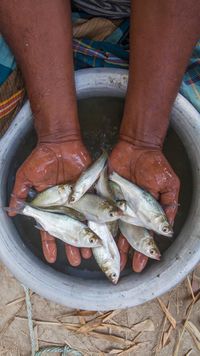Renewable Microgrids for Off-Grid Fish Hatcheries and Surrounding Communities
Overview
|
Project |
Renewable Microgrids for Off-Grid Fish Hatcheries and Surrounding Communities |
|
|
Collaborators |
Renewable World (United Kingdom) Electro Solar Power Ltd (Bangladesh) United Finance Company (Bangladesh) Rahimafrooz Renewable Energy Ltd. (Bangladesh) | |
|
Location Applied |
||
|
Website |
Off-grid fish hatcheries in Bangladesh, and their surrounding communities, rely extensively on diesel and kerosene to provide electricity needed to pump water and provide light. Use of kerosene and diesel, in addition to being costly, pollutes the environment and threatens the food chain and human health. The households around hatcheries typically rear fish in small ponds, using fingerlings from the hatchery for part of the year. A cost-effective, clean energy solution is expected to reduce energy costs and increase productivity for hatcheries and household fish-raisers while also providing domestic energy access.[1]
Clean Energy Solution
The proposed solution will replace diesel generation with a micro-grid powered by economically viable renewable sources. The system will power hatchery water pumping activities and provide household-level renewable power through an innovative metering technology. The mobile metering and billing system will allow users to pay for their electricity using mobile money, either pre- or post-usage. The innovative joint venture business model will ensure that that hatcheries and surrounding households can afford the technical solution by bringing private sector investment that would otherwise not be attracted to renewable grid development. The use of fish hatcheries as a hub for clean power generation provides a guaranteed, niche market with a higher level of sustainable and economic success.[1]
Impact
The project will provide many economic benefits to the hatcheries using the system, as well as the surrounding communities. These benefits include reduced diesel costs due to the use of clean energy, increased profits and sales for the hatchery, increased sales of fingerlings to local farmers, increased employment, and increased sustainability of aquaculture practices. The availability of evening lighting will enable social and educational benefits, such as studying after dark and additional time for operation of homestead-based businesses. The project will also benefit technology value chains by investing in key research and development which can encourage investment from financial service providers and technology investors, making clean energy solutions more affordable for poor rural consumers.[1]
Organization
International Development Enterprises (iDE) has over 30 years’ experience in designing and delivering market based anti-poverty programs. The project is implemented in partnership with Renewable World—a UK-based charity tackling poverty using renewable energy. In addition, the following private sector partners will provide technical expertise: United Finance Company—a non-bank financial institution specializing in lease financing; Rahimafrooz Renewable Energy Ltd.—a pioneering solar company in Bangladesh; and Electro Solar Power Ltd.—the first solar PV manufacturer in Bangladesh.[1]
Further Information
- Website Powering Agriculture Homepage, Winners 2015
- Powering Agriculture: An Energy Grand Challenge for Development
- Bangladesh Energy Situation
- Website iDE (International Development Enterprises)
- Website Renewable World (United Kingdom)
- Website Electro Solar Power Ltd (Bangladesh)
- Webiste United Finance Company (Bangladesh)
- Rahimafrooz Renewable Energy Ltd. (Bangladesh)
References
- ↑ 1.0 1.1 1.2 1.3 Powering Agriculture: http://poweringag.org/innovators/renewable-microgrids-grid-fish-hatcheries-surrounding-communities























